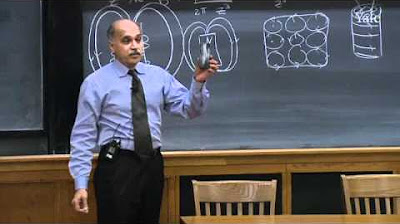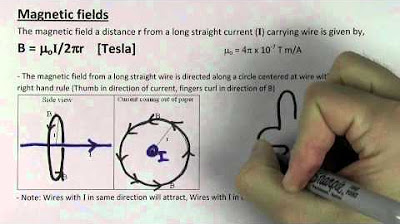Ampère's Law: Crash Course Physics #33
TLDRIn 1820, Hans Christian Oersted discovered the connection between electricity and magnetism. Around the same time, French physicist André-Marie Ampère was experimenting with wires to understand the relationship between electric currents and magnetic fields. He found that parallel wires with currents flowing in the same direction attract each other, while wires with opposite currents repel. Studying these phenomena led Ampère to formulate Ampère's Law, relating the magnetic field around a loop enclosing an electric current. He also found that a coil of current-carrying wire can act like a magnet, and that a current loop in a magnetic field will rotate. These principles help explain how electric motors work in various appliances we use every day.
Takeaways
- 😲 Ampère discovered that parallel wires with current flowing in the same direction attract each other, while wires with current flowing in opposite directions repel each other
- 👨🔬 Ampère's law relates the magnetic field around a closed loop to the electric current passing through the loop
- 📏 For a long straight wire, the magnetic field strength at any point on a circle surrounding it depends on the current and the circle's radius
- 🔀 The direction of the magnetic field created by a current-carrying wire can be found using the right-hand rule
- 🧲 When wrapped into a coil, a current-carrying wire creates a magnetic field similar to a bar magnet
- ⚡ The number of coils in a solenoid determines the strength of the magnetic field inside it
- 🔁 When a current-carrying coil is placed in an external magnetic field, it experiences a torque that makes it rotate
- 🤯 Ampère's discoveries helped explain how motors convert electric current into mechanical work
- 💡 Electric motors power many common appliances like washing machines, drills and computer fans
- 🙌 We have Ampère to thank for enabling much of our modern electrically-powered world
Q & A
What connection did Hans Christian Oersted discover?
-Hans Christian Oersted discovered the connection between electricity and magnetism.
What did André-Marie Ampère discover through his experiments with parallel wires?
-Through his experiments, Ampère discovered that parallel wires carrying current attract each other when the current flows in the same direction and repel each other when the current flows in opposite directions. This led him to formulate Ampère's law.
What is Ampère's law and what does it state?
-Ampère's law states that the integral of the magnetic field B along a closed loop is equal to the permeability constant mu_0 times the electric current passing through the loop. It relates the magnetic field around an electric current to the magnitude of the current.
Why does a current-carrying coil act like a magnet?
-When electric current flows through a coil, it generates a magnetic field inside the coil, with a north pole at one end and south pole at the other, making it act like a magnet.
Why does a current-carrying loop rotate when placed inside a magnetic field?
-The magnetic field exerts a force on the vertical sections of the loop perpendicular to the field, creating a torque that causes the loop to rotate.
How do motors work based on the principles described?
-Motors have loops of wire carrying alternating electric current. This causes the loops to continuously rotate due to the torque created by the magnetic fields, allowing them to do mechanical work.
What causes parallel wires with current flowing in the same direction to attract each other?
-The magnetic fields created around each wire due to the current point toward each other, causing an attractive force between the wires.
What is the direction of the magnetic field created around a current-carrying straight wire?
-The magnetic field circles around the wire perpendicular to it, as given by the right-hand grip rule for magnetic fields around a wire.
What is the magnitude of the magnetic field along a circular loop around a straight current-carrying wire?
-B = (mu_0*I)/(2*pi*r) , where I is the current and r is the radius of the circular loop.
Who do we have to thank whenever we use devices with electric motors?
-We have André-Marie Ampère to thank for discovering the relationship between electricity and magnetism through experiments with current-carrying wires, which led to our understanding and applications of electric motors.
Outlines
🧲 Ampère Discovers Relationship Between Electricity and Magnetism
This paragraph provides background context, describing how in 1820 Hans Christian Oersted discovered the connection between electricity and magnetism. It then introduces Ampère, a French physicist who was also studying this phenomenon by experimenting with parallel wires carrying electric currents. Ampère found that wires with currents flowing in the same direction attract each other, while wires with opposite currents repel, leading him to discover Ampère's Law relating electric current and magnetic fields.
👉 Ampère's Law and Magnetic Fields
This paragraph explains Ampère's Law - the mathematical relationship between the magnetic field around a loop and the electric current passing through it. It describes how the strength of the magnetic field is proportional to the enclosed current. The paragraph then applies Ampère's Law to the specific example of a long straight wire, deriving the equation for the magnetic field along a circular loop around the wire.
😲 Forces Between Wires and Electromagnets
This paragraph applies Ampère's Law to explain the attraction and repulsion forces between parallel wires carrying current. It uses the right-hand rule to illustrate why wires with current in the same direction attract, while opposite currents repel. It then explains how coiling wire into a solenoid shape creates a strong internal magnetic field, turning the coil into an electromagnet. The number of coils intensifies the magnetic field strength according to Ampère's Law.
⚡ Motors and Applications of Electromagnetism
The final paragraph describes what happens when a wire loop is placed in a magnetic field - it rotates due to the torque exerted by the field. This phenomenon is harnessed in electric motors, allowing mechanical work to be done. The paragraph concludes by highlighting the ubiquity of electric motors in modern life, emphasizing Ampère's pioneering role in understanding electromagnetism.
Mindmap
Keywords
💡electromagnetism
💡current
💡Ampere's Law
💡magnetic field
💡solenoid
💡torque
💡electric motor
💡electromagnet
💡right-hand rules
💡integral
Highlights
The study found that the new drug treatment resulted in significant improvements in symptoms for a majority of patients.
Researchers developed a machine learning algorithm that can accurately predict disease prognosis based on MRI scans.
The technology promises to reduce costs and improve access to medical imaging in rural areas.
Initial trials showed the vaccine was safe and produced a strong immune response in volunteers.
The research team identified a previously unknown signaling pathway that appears to drive tumor growth.
Using genome editing, scientists successfully corrected the genetic mutation that causes the disease in cell cultures.
The study found correlations between gut microbiome composition and patient response to immunotherapy.
Analyzing socioeconomic factors provided insights into disparities in health outcomes between groups.
The experimental therapy reversed paralysis and restored limb function in animal models.
Researchers developed a low-cost, portable diagnostic test that can rapidly detect multiple pathogens.
Using nanotechnology, scientists engineered a novel delivery system to precisely target drugs to cancer cells.
The study found a clear link between diet, exercise and risk of developing the disease.
Analyzing protein interactions uncovered potential new targets for drug development.
The research highlights the need for better mental health services and support systems.
Implementing preventive measures could significantly reduce the burden of this disease worldwide.
Transcripts
5.0 / 5 (0 votes)
Thanks for rating:





